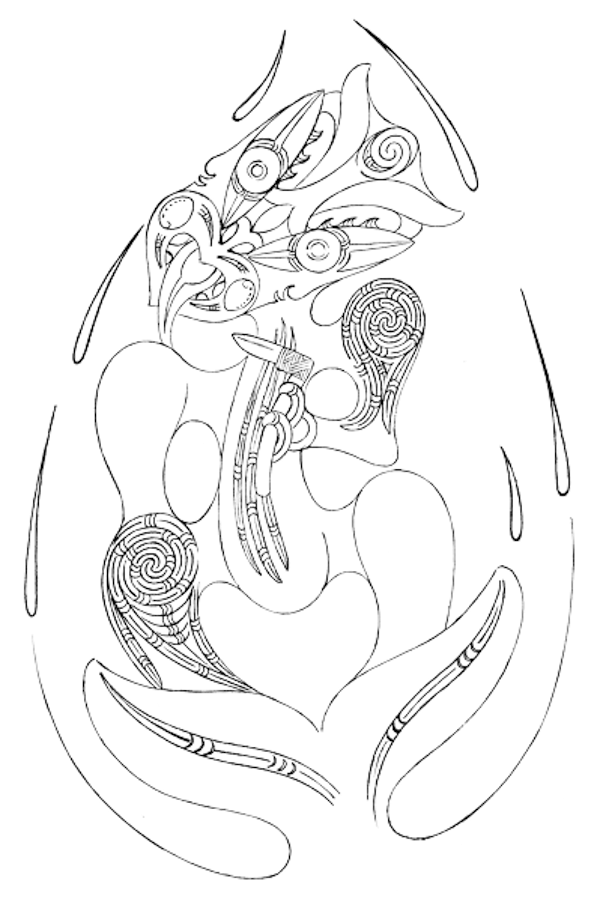
Tangaroa: associations with sea and fish, qualities of rhythmic, tidal surging, calm.
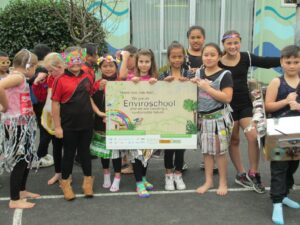
Celebrating Silver
Paeroa Central School was acknowledged as a Silver Enviroschool in 2017. Following their Silver reflection, the school underwent significant change including a change of all staff, the roll almost halving, and a rumaki unit being established. The new Principal, teachers and students needed to settle into this phase and find their own way. The Enviroschools programme was put on the ‘back burner’ for a couple of years.
I had been involved with this school as Enviroschools facilitator for 10 years, from creating a Vision, to reflecting at Bronze and then at Silver stage. In early 2020 a staff meeting was held to explore the Enviroschools kaupapa, re-energise the programme in the school and get everyone on board.
Over the year it became clear that with most of the people involved in the Silver reflection and the original Vision map gone, a revision of the whole school Vision was needed.
In 2021 the Principal employed me as an ‘Enviro-teacher’ for one day a week, working with each class during teachers CRT (classroom release time). Alongside this work each class was exploring the theme of ‘Tūrangawaewae’ and getting to know their local place. Integrated throughout school life is ‘Te Ara Whakamana’ (The Mana Enhancement Model) which is a culturally based tool using values related to the Atua for positive behaviour change, so the students had an existing understanding and value of atua Māori. Pepeha were already integrated into classroom life, and many aspects of ‘Me in My Environment’ were evident in other ways in the school.
Where have we come from and what do we know now?
Initially I thought I would delve into the Enviroschools ‘Me in My Environment’ resource and activities with students over the first term and begin the 2nd term working on the vision. As is often the case, things took longer than intended. Because of the limited time with students (up to an hour with each class, each week), we didn’t start creating the actual Vision map till later in term 2.
I used the ‘Me in My Environment’ learning guide and the Action Learning Cycle to guide my planning. This included many experiential activities as well as stories, books and songs to support the exploration of the key concepts.
We started the journey looking at what had already happened in the school. This meant first looking at the students’ understanding of ‘sustainability’, or, for the junior classes their understanding of ‘nurturing people and nature’. Their ideas around ‘sustainability’ and what was already happening, formed the inner circle of our visual learning record.
What can we observe and what can we learn?
From there, each class took a tour of the school, looking at/ observing all different spaces and things they had identified. They then pooled their understanding of how these came to be there, how those things were working, who was responsible for looking after them, how they were looking, and if they were used. The students were then asked what could be developed, re-energised, or improved.
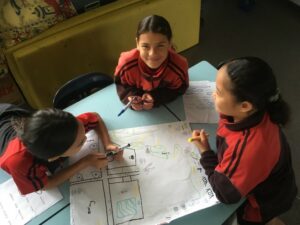
Mapping our kura.
The next stage was ‘Mapping My Place’. Free-hand drawing of a map of the kura was met with a mixed response – some of the students loved this and some began with a roar then lost heart because they found it hard to get that bird’s eye concept, and it was taking a long time to complete. Because of the limited time I had with them, I decided to offer enlarged printed aerial maps to those who wanted them and kept a communal map to record shared knowledge and ideas.
When groups had created their maps, they added in the areas that they had identified as already ‘caring for people and nature’. This included, the orchard, the mara kai, native tree area, compost bins, recycling area, play areas, hall where they have assemblies and practice Kapa haka and other significant places in the school.
At another session we used a “word hunt” to represent their feelings about areas of the kura. Initially they worked in pairs or groups with a positive and negative word each and identified an area of the school that they felt represented that feeling/description. We gathered round the communal map, and they placed these words on to the areas identified, sharing why they chose to put them where they did. They then worked in their groups to write the ones that resonated for them on their own maps.
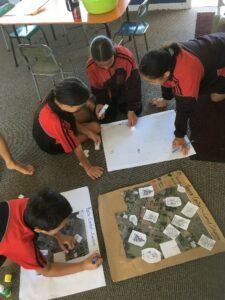
Ko wai ngā atua kei to kura?
At the following session, the students lay or sat with their eyes closed and listened to the story of creation from te ao Māori perspective. With the junior class I used the picture book ‘In the Beginning’ by Peter Gossage. We explored through movement, the qualities of the various atua Māori in the story and they chose their favourite one to draw using pastels. We walked around the kura as a group discussing what atua they sensed in various places. We then returned to our large map and placed small images of the atua Māori where they thought they should go, discussing this as each was added.
To explore the concept of kaitiakitanga, I used the beautiful story of ‘The Koroua and the Mauri Stone’ by Robyn Kahukiwa. We read and discussed the story of a Koroua who remembered how the land had looked when he was young and set about to bring the birds back.
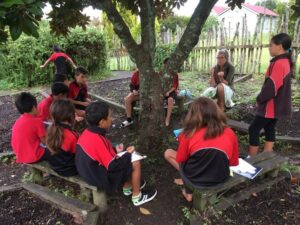
Observations using our senses.
We went out into the school’s native tree area, used as a lunch area with large specimen native trees and seating but no understory. I used sensory activities to help ākonga explore this area. They had fun observing, smelling, listening, and touching.
While out and about around the kura, they discovered abundant plum trees they didn’t know existed and were amazed when we found ripe kahikatea berries, so sweet. They collected the seed from the end of these fruit with great excitement and we sowed them at our next session.
In the māra kai they delighted in the taste of the honeysuckle and the smells of lavender and rosemary. They discovered the amazing transformation of rhubarb, some loved, while others loathed the flavour of the crumble we made from the rhubarb brought in from the garden. They were excited to discover the feijoa tree down the very back of the field and learnt that you needed to wait till the fruit have fallen to taste a sweet one.
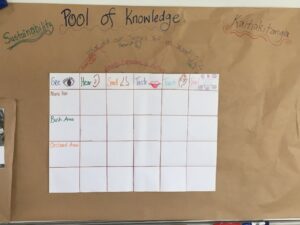
Starting the pool of knowledge with recording observations.
I created simple template for the older students to use to record their sensory experiences in different parts of the school then added their ideas to a big class template. The idea was to get to know their environment in a really ‘felt’ way.
What can we learn about Waste in our Kura?
In order to gather their ideas around reduction of waste at Paeroa Central, it was important to delve into further learning, asking ‘what is waste?’ and ‘why do we need to reduce it?’ For this I referred to the Enviroschools Zero Waste resource. We looked at the kind of waste we find around the school and where it was currently going. Some students carried out a mini waste audit of one of the big recycling bins and discovered it actually had lots of waste that would need to go to landfill.
To deepen their understanding of organic and inorganic, we looked at how Papatūānuku deals with waste through a leaf litter search while also collecting autumn leaves for the compost heap. The students had fun playing with and throwing around oak leaves we found in a thick carpet on our walk.
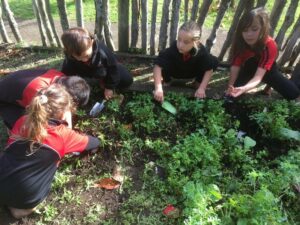
Bury it and dig it up.
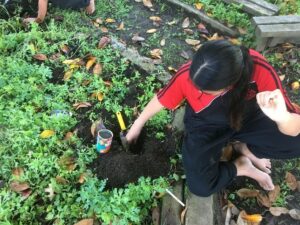
Experiential activity from Enviroschools Zero Waste resource that helps build understanding of waste.
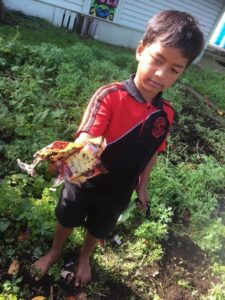
Thinking about waste and what happens.
We compared these natural materials to man-made materials through doing the ‘bury it’ activity, another one from the Enviroschools Zero Waste resource. The students were keen to dig their ‘treasures’ up each couple of weeks and observe what was happening. After 6 weeks we used a timeline activity to place different pieces of waste along, with students predicting how long things might take to break down and then learning the actual time, they were fascinated with this learning. I also told the story of paper using a large home-made version of paper manufacture sequence cards.
While out and about on some of our outdoor explorations we looked at the storm water drains and discussed where they go and the danger of plastics and other pollutants washing down to the moana (Tikapa Moana).
At the end of this exploration of waste we brainstormed our current ideas of “how can we reduce waste at Paeroa Central?’ and ‘how can we care for Tangaroa more?’ These ideas were later added to others and formed part of our vision map.
What can we measure?

Carrying out the Envirosurvey.
After all our exploration, students worked in groups to complete an Enviro-survey of the school. This helped to look at the nitty gritty of what was happening in the school around sustainability and uncovered some things the students hadn’t previously considered in their explorations. It was a good lead-up/ prompt to the final activity of gathering their ideas for change in the school.
What could we change if we could?
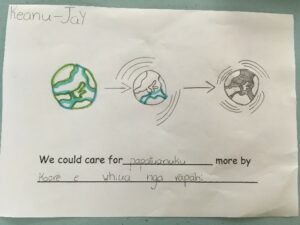
We could care for Papatūānuku more by…
At the end of the various activities, they worked in groups moving around bus stop sheets with these questions in the centre.
- How do we want our kura to look and feel?
- How do we want our students to be?
- What do we want to do in our school?
- How can we care for the children of Tānemahuta more?
- How can we care for Rongomātāne more?
- How can we care for Tangaroa more?
The younger students chose an atua and created a picture filling in the blanks in this sentence: “We can care for … more by …”
Including teachers’ ideas in the Vision
Once most of the mahi had been done, we had a staff meeting where teachers came into the classroom and looked at what the students had done so far. They also completed the Envirosurvey and added their own ideas to the list of changes people wanted to see happen in the kura.
Benefits of exploring their environment
Through all these activities, we would get outside when we could. There are sometimes challenges to managing a large group of students outside and also important that outside learning takes place to develop their connection to nature, whanaungatanga. I noticed the ākonga pleasure at discovering treasures around the school, exploring places, like a wild area at the back of the field. Things arose in those experiences I hadn’t planned, like discovering the seeds on the harakeke and the kowhai, arousing the interest to learn how to sow them so taking them back to the classroom to do just that.
Last year we made our Vision Map so that we were focussed and knew what to do, find a way out of things. To know what to do next, to know. – Robert Y3 student
Ideas for Te Kura Tuatahi o Paeroa
Once all the classes had created their group maps, contributed to the Puna Mātauranga, completed the survey and brainstormed ideas for change, an Envirogroup was formed. The initial task was to collate all the ideas from students and teachers and create a Vision Map for the kura, then to be part of the on-going mahi to start to explore and implement some of these ideas in the school.
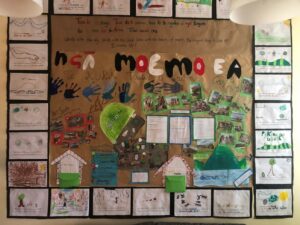
The new Vision Map!
We booked in a whole day to do this and needed to complete it over a few more hour-long sessions. They talked to the kaiako from the Rumaki classes to create the title Ngā Moemoea (Our Vision).
I liked following the Vision Map so we didn’t forget what was important and mark it off. – Awatea Y6 student
The Vision map was shared at a staff meeting and then erected in the foyer of the kura with an invitation to everyone to add any thoughts or ideas on sticky notes to it. This will help keep the vision alive!
Principal’s Perspective:
Tena koe, At Paeroa Central School, the [Enviroschools] programme continues to be an important focus in our school strategic plan 2022. Although at the renewal stage, with a new lead teacher and enviro team, we are excited to build on the vision from 2021.
The collaborative vision map and student-led projects guided the kaupapa, and values of our school, weaving together the ‘Big Idea’ for 2022: Mana Motuhake – Identity and Belonging and our inquiry: Pēhea ngā ō tātou Tīpuna e whakaatau ana mātou? How do the actions of our ancestors define us? What will be our footprint?
Continuing on from the work of Whaea Beccy, we are further developing sustainable practices in 2022 which will improve skills and knowledge in growing vegetables and fruit, cooking produce, reducing rubbish, and composting. Student representatives from each class will lead the school as an Enviro committee (Eco Warriors) to be part of implementing and guiding the vision and whole school projects. From this staff and whanau are represented with their ideas shared and summarised in the strategic plan –
We want our children to gain a connection to their place and whakapapa through working together (Mana Tū)
We want our students to develop a sense of belonging (Mana Whenua), to the Environment (Mana Ūkaipō), to the people (Mana Motuhake) and to the Community (Mana Tangatarua).
– Mona Hingston
“Toitū te marae a Tāne-Mahuta, Toitū te marae a Tangaroa, Toitū te tangata.” – If the land is well and the sea is well, the people will thrive.
I really liked going to the other school and pruning the trees, then showing others at our school how to do it. We trimmed our own trees, the orchard. I remembered some of the tips he said like cutting off broken branches, by the bud and to make a bowl-shaped tree so that the fruit could grow. – Te Koha Y6 student
